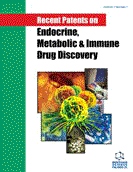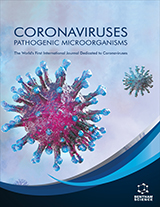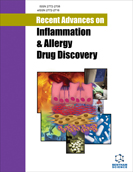Abstract
Neutrophils Extracellular Trap (NET) is composed of nuclear chromatin with hyper segmentation of nuclear lobes, citrullination of histone-associated DNA and mixing with cytoplasmic proteins including the enzyme myeloperoxidase. It is believed that neutrophils trap can kill microorganisms and constitutes a new form of innate defense. However, in some conditions, NET formation may be detrimental to the organism due to its association with autoantibody formation. Thus, NETs can be beneficial or detrimental depending of the DNA clearance recent registered patents describing the processes, products, methods and therapeutic indications of the neutrophil extracellular trap (NET) phenomenon have been reported. The patents US8710039; EP2465536; EP2651440; US20130302345; US20140099648; US20130183662; WO2012166611; and RU2463349C2, related to NETosis, suggest an association between NET formation and autoimmunity. However, its function is still not fully understood. Some parasites have learned to escape from NET using nucleases. NET persistence could be due to a possible enzymatic inhibition as suggested in Grabar´s theory for explaining the induction of physiologic or pathologic autoantibodies. In the present mini-review NET persistence due to impairment in the homeostasis clearance of DNA is discussed.
Keywords: Autoantibodies, detrimental tissular effect, DNA, homeostasis, Grabar´s theory, neutrophils extracellular trap.
Recent Patents on Endocrine, Metabolic & Immune Drug Discovery (Discontinued)
Title:Impaired Clearance of Neutrophils Extracellular Trap (NET) May Induce Detrimental Tissular Effect
Volume: 8 Issue: 3
Author(s): Paula M.F. Anjos, Fernanda S. Fagundes-Netto, Caroline M.O. Volpe and Jose A. Nogueira-Machado
Affiliation:
Keywords: Autoantibodies, detrimental tissular effect, DNA, homeostasis, Grabar´s theory, neutrophils extracellular trap.
Abstract: Neutrophils Extracellular Trap (NET) is composed of nuclear chromatin with hyper segmentation of nuclear lobes, citrullination of histone-associated DNA and mixing with cytoplasmic proteins including the enzyme myeloperoxidase. It is believed that neutrophils trap can kill microorganisms and constitutes a new form of innate defense. However, in some conditions, NET formation may be detrimental to the organism due to its association with autoantibody formation. Thus, NETs can be beneficial or detrimental depending of the DNA clearance recent registered patents describing the processes, products, methods and therapeutic indications of the neutrophil extracellular trap (NET) phenomenon have been reported. The patents US8710039; EP2465536; EP2651440; US20130302345; US20140099648; US20130183662; WO2012166611; and RU2463349C2, related to NETosis, suggest an association between NET formation and autoimmunity. However, its function is still not fully understood. Some parasites have learned to escape from NET using nucleases. NET persistence could be due to a possible enzymatic inhibition as suggested in Grabar´s theory for explaining the induction of physiologic or pathologic autoantibodies. In the present mini-review NET persistence due to impairment in the homeostasis clearance of DNA is discussed.
Export Options
About this article
Cite this article as:
Anjos M.F. Paula, Fagundes-Netto S. Fernanda, Volpe M.O. Caroline and Nogueira-Machado A. Jose, Impaired Clearance of Neutrophils Extracellular Trap (NET) May Induce Detrimental Tissular Effect, Recent Patents on Endocrine, Metabolic & Immune Drug Discovery (Discontinued) 2014; 8 (3) . https://dx.doi.org/10.2174/1872214808666141015120450
| DOI https://dx.doi.org/10.2174/1872214808666141015120450 |
Print ISSN 1872-2148 |
| Publisher Name Bentham Science Publisher |
Online ISSN 2212-3334 |
 40
40Related Articles
-
Could Targeting HMGB1 be Useful for the Clinical Management of COVID-19 Infection?
Combinatorial Chemistry & High Throughput Screening Recent Insights into the Role of Prostanoids in Atherosclerotic Vascular Disease
Current Vascular Pharmacology All in the Family: The TNF-TNFR Superfamily in the Pathogenesis and Treatment of Rheumatoid Arthritis and other Inflammatory Diseases
Current Medicinal Chemistry - Anti-Inflammatory & Anti-Allergy Agents Human Immunodeficiency Virus (HIV) and Stroke: Targets for Intervention
Infectious Disorders - Drug Targets Redefining the Role of Long-Acting Phosphodiesterase Inhibitor Tadalafil in the Treatment of Diabetic Erectile Dysfunction
Current Diabetes Reviews Human Parvovirus B19: An Infectious Agent with the Potential to Induce and Trigger Rheumatic Disease
Current Rheumatology Reviews Rheumatoid Foot and Ankle Surgery
Current Rheumatology Reviews Musculoskeletal and Rheumatic Diseases Induced by Immune Checkpoint Inhibitors: A Review of the Literature
Current Drug Safety Biologic Agents in the Treatment of Rheumatoid Arthritis
Current Pharmaceutical Biotechnology Small-Molecule Chemokine Receptor Antagonists: Potential Targets for Inflammatory and Allergic Disorders
Current Medicinal Chemistry - Anti-Inflammatory & Anti-Allergy Agents Concurrence of Talaromycosis and Kaposi Sarcoma in an HIV-Infected Patient: A Case Report
Current HIV Research Distribution Characteristics of ANA and ANCA in Patients with Hyperthyroidism
Endocrine, Metabolic & Immune Disorders - Drug Targets PPARγ Activation Improves the Molecular and Functional Components of Ito Remodeling by Angiotensin II
Current Pharmaceutical Design Antitumoral Alkylphospholipids Alter Cell Lipid Metabolism
Anti-Cancer Agents in Medicinal Chemistry Gauging Reactive Metabolites in Drug-Induced Toxicity
Current Medicinal Chemistry Retinoids as Critical Modulators of Immune Functions: New Therapeutic Perspectives for Old Compounds
Endocrine, Metabolic & Immune Disorders - Drug Targets The role of interleukin 35 in atherosclerosis
Current Pharmaceutical Design Molecular Imaging of Vascular Inflammation
Current Pharmaceutical Design Mapping Myeloperoxidase to Identify its Promiscuity Properties Using Docking and Molecular Dynamics Simulations
Current Pharmaceutical Design Type I Interferon as a Target of Treatment in SLE
Endocrine, Metabolic & Immune Disorders - Drug Targets






















